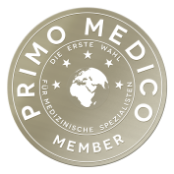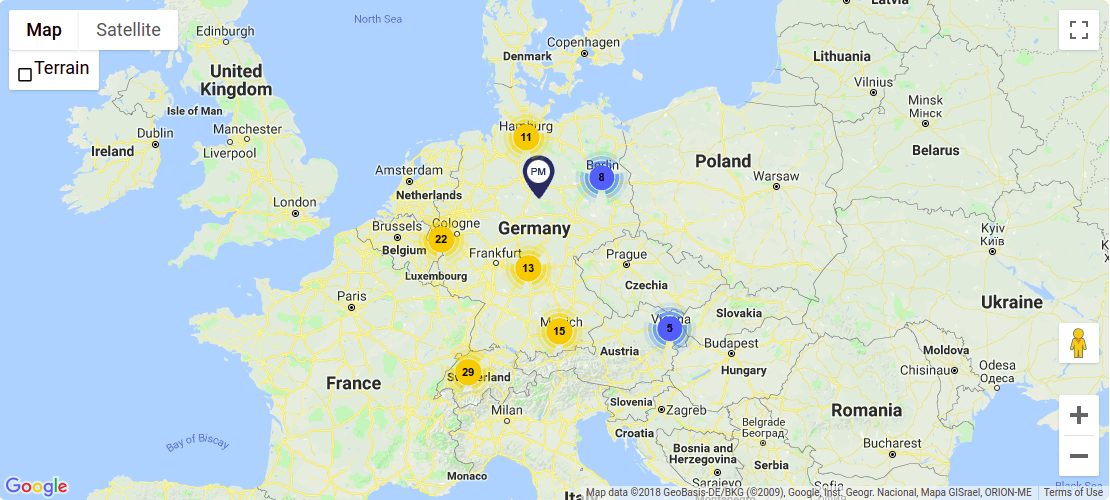Prof. Dr Martinus Richter – Bavarian Specialist in Foot and Ankle Surgery
Treatment focus
- Cartilage damage, including osteochondrosis dissecans
- Foot instability and deformity
- Arthrosis, including hallux rigidus
- Tendon and ligament injuries
- Achillodynia/Haglund’s deformity/heel spur
- Neuropathy, diabetic foot syndrome, nerve congestion syndrome
- Fibromatosis
Contact
Rummelsberg Hospital
Clinic for Foot and Ankle Surgery
Rummelsberg 71, D-90592 Schwarzenbruck
P: +49 9128 405 4006 F: +49 9128 504 1300
Consultation Hours:
By prior arrangement

Medical Range
Range of Diagnostic Services
- Digital volume tomography (DVT) PedCAT – 3D X-ray in standing position
- Ultrasound
- Diagnostic arthroscopy
- Computer-aided deformity analysis
- Pedography
- CT
- MRI
Range of Therapeutic Services
- Cartilage surgery (microfracturing, navigated subchondral drilling, Autologous Matrix Induced Chondrogenesis (AMIC) with Peripheral Blood Concentrate (PBC))
- Ankle ligament reconstruction/replacement
- Endoprosthetics of the foot and ankle joint, including replacement
- Arthrodesis joint fusion
- Corrections of the foot in case of deformities (e.g. flat foot, hollow foot, hallux valgus, and claw toes)
- Ulcer rehabilitation and deformity correction
- Diabetic foot syndrome and/or neuropathy
- Osteosyntheses for fractures of the hindfoot, metatarsus, and sesamoid bones
- Navigation
- Intraoperative 3D X-ray imaging
- Intraoperative pedography
- Insole/shoe/orthotic care
More Information
Card
Prof. Dr Martinus Richter is a specialist in foot and ankle surgery and chief physician at the clinic for foot and ankle surgery at the Rummelsberg Hospital.
Professor Richter and his team of doctors offer comprehensive and innovative surgical and non-surgical therapies for foot and ankle problems at any age.
First Maximum Care Center for Foot and Ankle Surgery
The clinic for foot and ankle surgery at the Rummelsberg Hospital in Bavaria has been certified as the first maximum care center for foot and ankle surgery in Germany. The clinic near Nuremberg is pioneer in the establishment of unified centres and is currently the only one to have a foot dispensary included in the hospital bed plan. The foot clinic offers comprehensive and innovative surgical and conservative treatment of foot diseases and ankle problems at any age. Prof. Dr Martinus Richter and his team look after their patients in close cooperation with private practice specialist physicians and therapists – from the first presentation to the last follow-up examination.
Modern Diagnostics of Foot and Ankle Diseases
At the Rummelsberg Hospital, the expert in foot and ankle diseases Prof. Richter has the most modern diagnostic facilities at his disposal. In addition to the conventional examination methods such as detailed anamnesis, X-ray, CT, ultrasound, and MRI, a digital image of the foot pressure load while standing up and walking (pedography) is created for each patient. The modern digital volume tomography (DVT) PedCAT produces a 2D or 3D X-ray analysis of the foot and ankle joint while the patient is standing up. This type of imaging under load allows for an analysis of foot deformities and instabilities because the bone position changes under load. Using PedCAT images, Prof. Richter plans individual therapy options for each patient.
Cartilage Surgery – Chondrogenesis with Peripheral Blood Concentrate
Professor Richter’s most significant medical focus is cartilage surgery at the Rummelsberg Hospital. This includes cartilage surgery methods such as microfracturing, navigated subchondral drilling, and especially Autologous Matrix Induced Chondrogenesis (AMIC) with Peripheral Blood Concentrate (PBC). Arthroscopy (joint endoscopy) is used as a tool for diagnosis and intervention. Cartilage surgery is applied not only for degenerative damage – it is also extremely useful for fresh injuries such as fractures or dislocations in the foot or ankle area. The aim of the operation is to preserve the joint. In most cases, concomitant problems such as instability and/or deformity are also treated. Endoprosthetics or arthrodesis are applied only if joint preservation is not possible (see below).
The Artificial Foot and Ankle Joint – New Prosthesis and Revision
In the case of arthrosis, the medical specialist Professor Richter implants the endoprosthesis of the upper ankle joint (OSG prosthesis). The ideal patient for an ankle replacement is someone with an ordinary hindfoot axis, good bones, and a good circulation. Professor Richter uses the medical history and diagnostic tools to analyse whether it is possible to implant an artificial ankle replacement. Different types of prostheses are adopted – depending on the location of the arthrosis in foot or toes. At the Rummelsberg Hospital, Professor Richter also performs replacement operations. Revision of an ankle joint prosthesis is performed in the following cases:
- Loosening of the inserted prosthesis
- Failure resulting from wear
- Infections
- Cysts underneath the prosthesis
- Dislocation of the prosthesis
- Fracture of the foot around the prosthesis
Arthrodesis of the Foot and Ankle Joint – Surgical Joint Fusion
Professor Richter is a medical specialist in the field of surgical joint fusion. Arthrodesis is routinely performed by Professor Richter at the Rummelsberg Hospital in the case of advanced arthrosis or severe joint damage. The procedure eliminates chronic pain from a joint affected by arthrosis. Arthrodesis is also used to fix an unstable joint or to correct joint deformity. Surgical joint fusion, which is often performed at the foot and ankle joints, requires an experienced surgeon. The necessity of the surgical intervention is determined diagnostically by Professor Richter, planned in detail, and discussed with the patient. Different anaesthetic procedures can be offered for the surgery. During the incision, the bones are connected and fixed with the help of screws, intramedullary nails, and plate implants (joint fusion). Most joint fusions of the foot do not lead to any mobility restrictions in everyday life or sports but rather improve movability.
Correction of Foot Deformities – Hollow Foot, Flat Foot, Hallux Valgus, and Claw Toes
As a specialist in foot and ankle surgery, Professor Richter treats various types of deformities. His surgical therapy spectrum also includes hallux rigidus, rigid big toe joint as a result of arthrosis, hallux valgus, flat feet in both adults and children, as well as hollow feet.
Achillodynia – Pain Syndrome of the Achilles Tendon
Achilles tendon pain syndrome, also referred to as achillodynia or dorsal heel spur, belongs to the insertional adentopathies such as golfer’s elbow or tennis elbow. It is a painful inflammation of the tendon tissue triggered by overuse of the tendon, arthritic changes in the ankle joint, or foot deformities. The pain occurs above the tendon insertion at the heel bone. With the help of a clinical examination and an X-ray performed while the patient is standing under load, Professor Richter diagnoses achillodynia and successfully operates on it. Following the surgical intervention is an immediate full weight-bearing after-care with a ready-made shoe with heel elevation.
Tendon Injuries – Tear of the Achilles Tendon
Tears of the Achilles tendon are treated by Professor Richter in cooperation with the departments of Trauma and Restorative Surgery, Sports Medicine, and Sports Traumatology at the Rummelsberg Hospital. A torn Achilles tendon occurs when the calf muscles are suddenly strained during sporting activities (e.g. football or handball) and affects males more often than females. Professor Richter diagnoses a torn Achilles tendon by means of a thorough examination and ultrasound. A torn Achilles tendon is repaired exclusively surgically, whereby the surgery is carried out in a minimally invasive procedure or percutaneously with the “Dresden instrument”. After the surgical intervention, the foot is immobilised for a longer period of time to avoid hindering the recovery of the Achilles tendon.
“Fast-Track” Therapy Concept of Foot Surgery
In the field of foot and ankle therapy, the modern “Fast-track” treatment concept is unique in Germany and applied by Professor Richter at the Rummelsberg Hospital in Schwarzenbruck. Thanks to a targeted education and physiotherapy ahead of the surgical intervention, patients can stand on their own feet again with the help of crutches and take their first steps the same day of surgery. In the case of ankle interventions (if support is necessary), mobilisation without crutches is possible with the help of a relief rollator (Orthoscoot). Targeted and intensive physiotherapy performed on a daily basis helps patients to recover quickly. While the surgical procedure itself is performed on an inpatient basis, diagnostics, surgery preparations, and follow-up treatments are mostly given on an outpatient basis. Pedography is adopted in all patients.
Further information about Prof. Dr Martinus Richter is available here.
Curriculum Vitae
| 1990 – 1996 | Medical studies at the University of Freiburg |
| 1995 – 1996 | Practical year: Orthopaedics: Department of Orthopaedic Surgery, University of Pittsburgh, USA Trauma surgery: Trauma Surgery Clinic, University Hospital Freiburg Internal medicine: Thurgauisch Schaffhausische Höhenklinik Davos, Switzerland |
| 1996 | Doctorate: “Kinesiological studies on gait analysis with tracers"” Anatomical Institute, Albert Ludwigs University Freiburg i. Br. (Grade: magna cum laude) |
| 01.01.1997 | Start of continuing education at the Trauma Surgery Clinic of Hannover Medical School (MHH) |
| 1999 | Additional title in “rescue medicine” (cf. emergency medicine) |
| 2001 | Additional title in “sports medicine” |
| 2002 | Habilitation: “Origin, treatment, and prevention of metatarsal fractures. Clinical, accident related, and experimental studies.” Acquisition of the Venia legendi for the subject "Experimental Trauma Surgery” |
| 2002 | Regional titel “Surgery” |
| 2002 | Completion of accompanying studies in business administration for doctors with the degree “Health economist” |
| 15.07.2003 – 31.08.2006 | Senior Physician at the Trauma Surgery Clinic of Hannover Medical School (MHH) |
| 2004 | Speciality titel “Trauma surgery” |
| 2005 | Regional titel “Orthopaedics and trauma surgery” |
| 2006 | Additional titel “Traffic medical assessment” |
| 2006 | Speciality titel “Trauma surgery” |
| 01.09.2006 – 30.09.2010 | Chief Physician 2nd Surgical Clinic (Trauma Surgery, Orthopaedics, and Foot Surgery), Coburg Hospital |
| 13.09.2006 | Appointment as “Adjunct Professor” of the Hannover Medical School (MHH) |
| 2009 | Certificate in Foot Surgery from the German Association for Orthopaedic Foot Surgery (DAF) |
| 01.10.2010 – 30.09.2011 | Chief Physician of Trauma Surgery, Orthopaedics, and Foot Surgery at Coburg Hospital and Hennberg Hospitals Hildburghausen |
| from 01.10.2011 | Chief Physician of Foot and Ankle Surgery Clinic Rummelsberg Hospital and Sana Clinic Nuremberg |
Team
- Stefan Zech
Chief Senior Physician - Dr Stefan Meissner
Senior Physician - Issam Naef
Senior Physician
Transport Connections
| Ochenbruck Railway Station | 1.5 km |
| Nuremberg Airport | 35 km |
| Munich Airport | 147 km |
| Frankfurt Airport | 252 km |
Information about Nuremberg
The second-largest city in Bavaria comes across as entirely unexciting. But Nuremberg is characterized by the historic buildings of the old town, surrounded by the imposing city wall. On the sandstone mountain, the medieval Kaiserburg is enthroned and gives the view over the city's roofs and the most important churches of Nuremberg. Additionally, museums, sights, shopping miles, and fancy stores make Nuremberg a lively town with a lot of atmosphere and flair.











